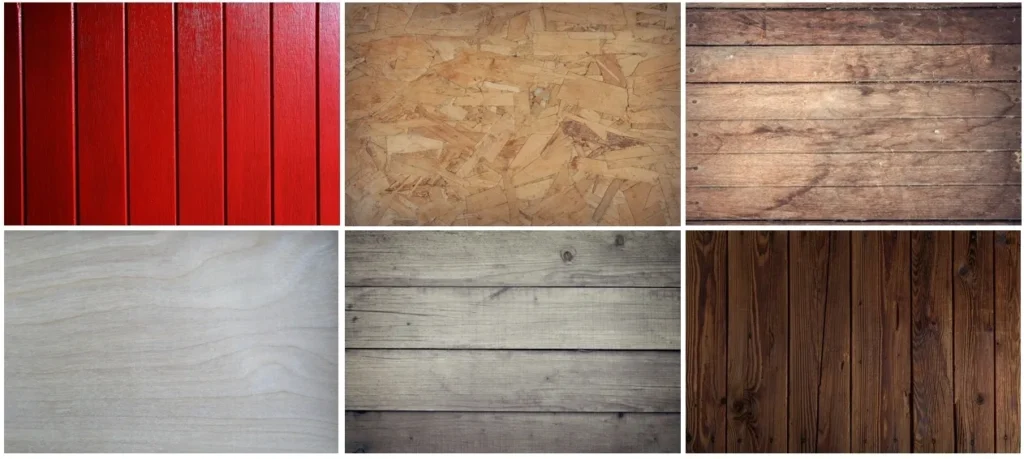Wood is a versatile and timeless material in interior architecture, offering a variety of finishes, durability levels, and aesthetics to suit different design needs. Here’s a guide to some of the most popular types of wood used in interior architecture, each bringing its unique charm and functionality to spaces.
1. Oak
Characteristics: Oak is a strong, dense hardwood with a prominent grain pattern and a warm, honey-colored tone. Available in red and white varieties, white oak has a slightly finer grain and a more subtle tone, while red oak has a reddish undertone.
Applications: Oak is widely used for flooring, cabinetry, and furniture due to its durability and resistance to wear.
Style Compatibility: Works well with traditional and rustic styles, but can also be used in modern designs for a warm, textured look.
2. Walnut
Characteristics: Walnut is a dark, rich hardwood known for its straight grain and deep, chocolate-brown color, which can range from light brown to deep purples.
Applications: Often used for cabinetry, accent furniture, and decorative paneling, walnut is prized for its luxurious look and smooth finish.
Style Compatibility: Walnut’s deep tones add elegance to contemporary and modern spaces, and it’s often used in high-end interiors.
3. Maple
Characteristics: Maple is a light-colored hardwood with a smooth, subtle grain. It’s very durable and resistant to scratches, making it ideal for high-traffic areas.
Applications: Maple is commonly used for kitchen cabinets, flooring, and furniture.
Style Compatibility: Its light tone suits minimalist and Scandinavian-inspired designs, blending well in spaces that favor neutral, clean aesthetics.
4. Cherry
Characteristics: Cherry wood has a warm reddish-brown hue that deepens with age. It’s moderately dense with a smooth grain, giving it a polished, elegant appearance.
Applications: Cherry is often used for high-end cabinetry, furniture, and wood paneling.
Style Compatibility: Its rich color suits traditional, transitional, and classic interiors, often adding a luxurious feel.
5. Pine
Characteristics: Pine is a softwood with a light, yellowish color and a distinct grain pattern. It’s more affordable and lighter than many hardwoods, though it can dent more easily.
Applications: Pine is used for wall paneling, ceiling beams, rustic furniture, and flooring in low-traffic areas.
Style Compatibility: Pine’s natural look and affordability make it popular in rustic, farmhouse, and cottage-style interiors.
6. Teak
Characteristics: Teak is a tropical hardwood known for its natural oils, making it highly resistant to moisture and insects. It has a warm, golden-brown color that darkens with age.
Applications: Due to its moisture resistance, teak is often used in bathroom furnishings, outdoor furniture, and accent pieces.
Style Compatibility: Teak’s durability and rich appearance make it a popular choice for luxury and eco-friendly interiors.
7. Mahogany
Characteristics: Mahogany is a dark, reddish-brown hardwood with a straight, even grain and a high level of durability. It resists warping and retains its color over time.
Applications: Commonly used in fine furniture, doors, and woodwork that requires a polished, high-end finish.
Style Compatibility: Mahogany is ideal for traditional and luxurious interiors, adding a sense of grandeur and warmth.
8. Birch
Characteristics: Birch is a light-colored hardwood with a fine, uniform grain and a smooth texture. It’s affordable, versatile, and easy to work with.
Applications: Birch is used for cabinetry, shelving, and paneling. Its light color also makes it a favorite for children’s furniture and other items that benefit from a lighter look.
Style Compatibility: Works well in modern and Scandinavian styles, as well as in spaces that favor light and airy aesthetics.
9. Ash
Characteristics: Ash wood has a light, creamy color with a straight, prominent grain. It’s strong yet flexible, making it suitable for various applications.
Applications: Ash is commonly used for furniture, flooring, and cabinetry, particularly for designs that require a durable yet flexible wood.
Style Compatibility: Ash works well in contemporary and mid-century modern interiors, as it brings a clean and natural look.
10. Douglas Fir
Characteristics: Douglas Fir is a light-colored softwood with a subtle grain pattern. It’s relatively strong for a softwood and has a warm, reddish undertone.
Applications: Frequently used in structural beams, paneling, and rustic furniture, Douglas Fir is versatile and widely available.
Style Compatibility: Ideal for rustic and industrial interiors, Douglas Fir also works in modern spaces as ceiling beams or paneling.
11. Ebony
Characteristics: Ebony is a dense, dark hardwood with a fine, smooth grain and a luxurious appearance. Its dark color is nearly black, making it highly sought-after for accents and unique pieces.
Applications: Used sparingly for high-end accents like inlays, decorative trims, and small furniture items due to its rarity and expense.
Style Compatibility: Ebony works best in sophisticated and contemporary spaces as an accent wood, adding a bold, dramatic touch.
12. Cedar
Characteristics: Cedar is a softwood known for its aromatic scent and natural insect resistance. It has a warm, reddish color that adds a distinct look to interiors.
Applications: Cedar is often used in closets, saunas, and outdoor furniture due to its moisture resistance and pleasant scent.
Style Compatibility: Cedar is common in rustic and cabin-style interiors, adding a cozy and natural element to spaces.
Each type of wood offers a distinct aesthetic and functional benefit, allowing designers and architects to select the best material based on the style, durability needs, and function of the space. From the warmth of oak and walnut to the boldness of ebony, these wood types can transform interiors, adding natural beauty, texture, and longevity to any architectural design.

